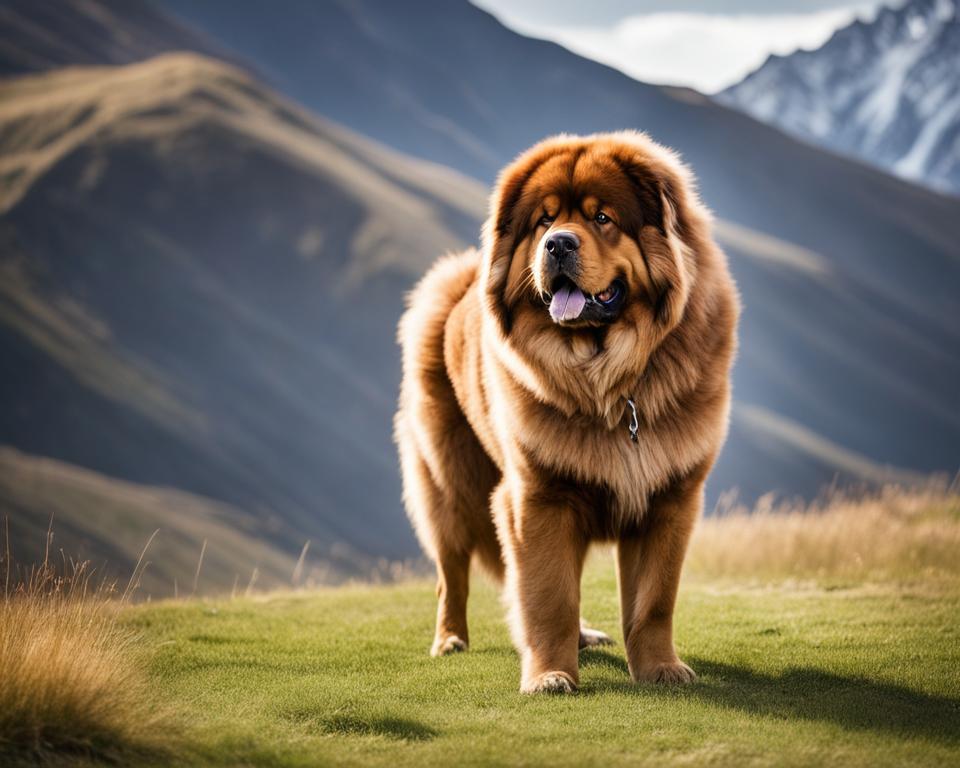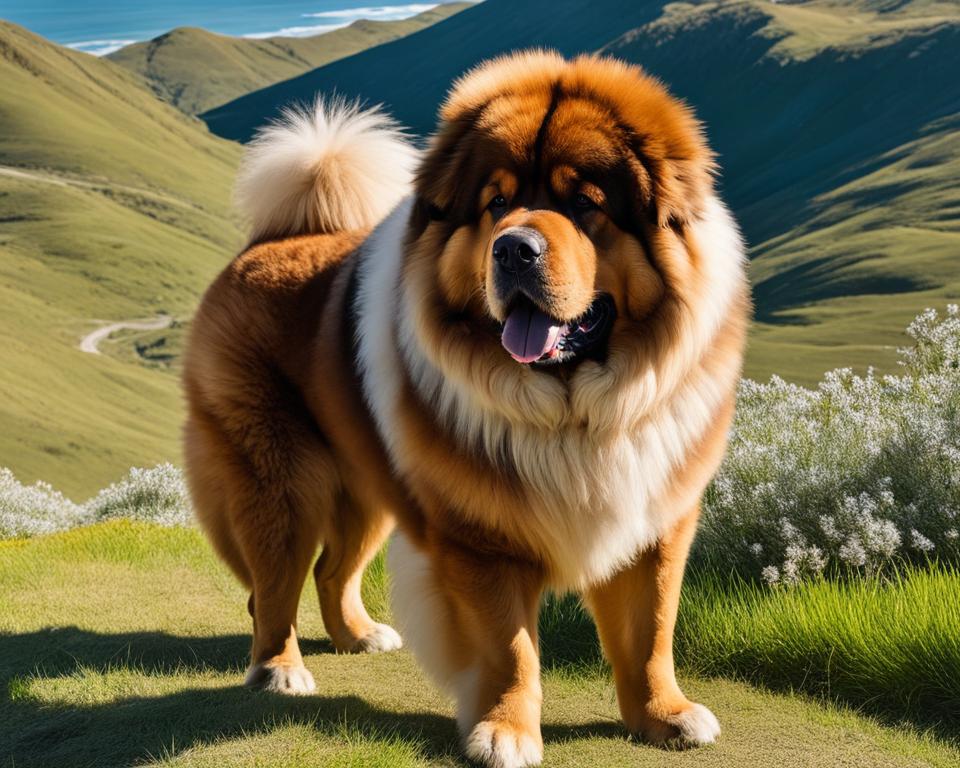The Tibetan Mastiff, a majestic and powerful dog breed, has captured the fascination of dog enthusiasts around the world. Originating in the rugged terrain of the Tibetan Plateau, these magnificent creatures possess unique characteristics that enable them to adapt to various climates. Whether it’s the chilly highlands or the warm lowlands, Tibetan Mastiffs showcase remarkable versatility in their ability to thrive in different environments.
One of the notable features of Tibetan Mastiffs is their double coat, which ranges in length depending on the climate they inhabit. This thick and insulating coat provides them with excellent protection from the elements, allowing them to withstand extreme conditions. Tibetan Mastiffs come in a wide array of coat colors, such as black, black and tan, shades of red, and bluish-gray, adding to their striking appearance.
These magnificent canines possess a strong protective instinct, making them exceptional guardians. However, due to their loyal and independent nature, Tibetan Mastiffs require a confident and experienced owner who understands their unique needs. Providing proper care and training is crucial in harnessing their potential and nurturing their remarkable traits.
Key Takeaways:
- Tibetan Mastiffs are adaptable to various climates, thanks to their double coat and protective instincts.
- Their thick coat provides insulation in colder environments, while appropriate measures should be taken to prevent overheating in hot climates.
- Proper care and training are essential to ensure their well-being and manage their protective behavior.
- Regular grooming, exercise, and a high-quality diet contribute to their overall health and happiness.
- Tibetan Mastiffs’ intriguing history and unique characteristics make them a fascinating breed with a dedicated following.
As we further explore the fascinating world of Tibetan Mastiffs, we’ll delve into their physical characteristics, temperament, behavior, and care requirements in various climates. Understanding these aspects will empower you to provide the best possible care for these magnificent canines, ensuring their comfort and well-being in every environment.
Physical Characteristics of the Tibetan Mastiff
The Tibetan Mastiff is a large-sized dog breed with striking physical characteristics. Males can reach a height of 66 cm (26 in), while females typically reach a height of 61 cm (24 in). These majestic dogs have a regal appearance that commands attention.
The Tibetan Mastiff is known for its dense, double coat, which provides protection in harsh climates. The coat can vary in length, with some individuals having a shorter coat while others have a longer, more luxurious coat. This variation allows Tibetan Mastiffs to adapt to different weather conditions, ensuring their comfort in various climates.
The coat of the Tibetan Mastiff comes in a wide array of colors, adding to their overall charm. Some common coat colors include solid black, black and tan, shades of red, and bluish-gray. Each color variation enhances the breed’s unique beauty and adds to their individuality.
With their impressive size, stunning coat, and distinct features, the Tibetan Mastiff is a truly remarkable breed.
Temperament and Behavior of the Tibetan Mastiff
Tibetan Mastiffs are known for their loyalty, courage, and protective instincts. They are naturally suspicious of strangers and make excellent guardians. The breed is intelligent and independent, but also stubborn, which can make training a challenge. Tibetan Mastiffs require early socialization and consistent training to prevent aggression towards strangers and other animals. They are generally aloof with strangers but can be loving and gentle with their family.
| Tibetan Mastiff Temperament | Tibetan Mastiff Behavior | Tibetan Mastiff Protective Instincts |
|---|---|---|
|
|
|

The temperament of Tibetan Mastiffs is characterized by their loyalty and courage. They are fiercely protective of their family and territory, making them highly effective guardians. However, their protective instincts can sometimes make them suspicious or aloof with strangers.
In terms of behavior, Tibetan Mastiffs are intelligent and independent, but they can also be stubborn. Training these dogs requires consistency, patience, and a confident owner who can establish authority. Early socialization is vital to ensure that they are comfortable around unfamiliar people and animals.
Their protective instincts are deeply ingrained, and they have a natural ability to detect potential threats. This makes them excellent guard dogs. However, proper socialization from an early age is essential to prevent aggression towards strangers or other animals.
Despite their formidable protective instincts, Tibetan Mastiffs can be loving and gentle with their family. They form strong bonds with their owners and are known to be affectionate and loyal companions.
Tibetan Mastiffs in Different Climates
Tibetan Mastiffs are a versatile breed that can adapt to various climates, thanks to their unique double coat. However, their thick and insulating coat makes them especially well-suited for colder environments. These majestic dogs can thrive in chilly highlands and are comfortable in cold temperatures.
In hot climates, Tibetan Mastiffs require extra care to prevent overheating. They should have access to shade and cool water at all times. It is important to monitor their physical condition closely and ensure they don’t overexert themselves during hot weather.
While Tibetan Mastiffs can adapt to moderate temperatures quite well, their heavy coat may make them more susceptible to heat-related issues in extremely hot and humid conditions. It’s essential to provide adequate shelter and take necessary precautions to keep them comfortable and safe in such environments.
Here are some key considerations for Tibetan Mastiffs in different climates:
- In cold climates, Tibetan Mastiffs thrive and enjoy the colder temperatures.
- In hot climates, they require access to shade and cool water to prevent overheating.
- In tropical climates, special care must be taken to protect them from the heat and humidity.
- In temperate climates, Tibetan Mastiffs adapt well but still require regular monitoring.
- In extreme climates, providing adequate shelter and monitoring their physical condition is crucial.
Understanding the needs of Tibetan Mastiffs in different climates is essential for their overall well-being and ensuring they thrive no matter the weather conditions.

Recommended Climates for Tibetan Mastiffs
| Climate Type | Suitability |
|---|---|
| Cold Climates | Highly suitable, comfortable in cold temperatures |
| Hot Climates | Requires shade and cool water to prevent overheating |
| Tropical Climates | Extra care needed to protect from heat and humidity |
| Temperate Climates | Adapts well, still requires monitoring |
| Extreme Climates | Proper shelter and physical condition monitoring are necessary |
Care Tips for Tibetan Mastiffs in Different Climates
Proper care is essential to ensure the well-being of Tibetan Mastiffs in different climates. These majestic dogs have a unique set of needs that should be addressed to keep them healthy and happy.
Grooming
Grooming is particularly important for Tibetan Mastiffs due to their thick double coat. Regular brushing at least twice a week is necessary to prevent matting and tangling. This helps maintain the coat’s health and remove any loose or dead hair. Additionally, regular grooming sessions provide an opportunity to inspect the dog’s skin for any signs of irritation or infection.
Exercise
Tibetan Mastiffs require daily exercise regardless of the climate they’re in. Regular physical activity is crucial to prevent boredom, obesity, and destructive behavior. A combination of walks, playtime, and mental stimulation activities should be incorporated into their routine. However, it’s important to consider the temperature and adjust the intensity and duration of the exercise accordingly, especially in extreme climates.
Diet
A high-quality diet that suits the Tibetan Mastiff’s size and activity level is essential for their overall health. The diet should consist of a balanced mix of proteins, fats, and carbohydrates. Consult with a veterinarian to determine the appropriate portion sizes and nutritional requirements based on the individual dog’s needs. It’s important to monitor their weight and adjust the diet as necessary to maintain a healthy body condition.
Veterinary Check-ups
Regular veterinary check-ups are crucial for Tibetan Mastiffs in different climates. These check-ups provide an opportunity to monitor their health, identify any potential issues before they become serious, and address any concerns or questions regarding their care. Vaccinations, parasite prevention, and dental care are also important aspects of their overall wellbeing and should be discussed with the veterinarian.
Health Considerations for Tibetan Mastiffs
Tibetan Mastiffs, like all dog breeds, are susceptible to certain health conditions that potential owners should be aware of. Regular veterinary care and a proper diet are essential for maintaining their well-being and managing these issues.
Common Health Issues
Tibetan Mastiffs are prone to several common health problems, including:
- Hip dysplasia
- Elbow dysplasia
- Eye problems
- Hypothyroidism
To ensure the best quality of life for your Tibetan Mastiff, it is crucial to monitor their health and provide necessary treatment or intervention when required. Regular veterinary check-ups can help identify potential issues early and prevent further complications.
Lifespan of Tibetan Mastiffs
The average lifespan of a Tibetan Mastiff is around 10-12 years. However, it’s important to note that individual dogs may vary, with some living longer or shorter lives depending on genetics and other factors.
Providing a nutritious diet, regular exercise, and a comfortable living environment can contribute to a longer and healthier lifespan for your Tibetan Mastiff.
| Common Health Issues | Average Lifespan |
|---|---|
| Hip dysplasia | 10-12 years |
| Elbow dysplasia | 10-12 years |
| Eye problems | 10-12 years |
| Hypothyroidism | 10-12 years |
Proper care, regular veterinary check-ups, and early intervention can contribute to a healthier and longer life for your beloved Tibetan Mastiff.
The History and Popularity of the Tibetan Mastiff
The Tibetan Mastiff, an ancient breed hailing from Tibet, has a rich history as a guardian and protector of livestock and monasteries. With its thick coat and imposing size, the Tibetan Mastiff thrived in the harsh climates of the Himalayan region. The breed’s origins can be traced back thousands of years, with evidence of their existence found in ancient cave paintings and writings.
In the 1800s, Tibetan Mastiffs gained popularity in Europe, where they captured the fascination of dog enthusiasts with their majestic appearance and unique heritage. From Europe, their popularity spread across the globe, captivating dog lovers in various countries.
However, the breed’s rise in popularity has come with some challenges. Overbreeding has led to potential health issues and the unsuitability of the Tibetan Mastiff as a pet in certain situations. As a large and powerful breed, they require knowledgeable and experienced owners who can meet their specific needs.
Therefore, before considering bringing a Tibetan Mastiff into your home, it is crucial to understand the breed’s history, origin, and unique requirements. A well-informed decision will ensure that the majestic and noble Tibetan Mastiff finds its rightful place in a loving and responsible household.
FAQ
Can Tibetan Mastiffs adapt to different climates?
Yes, Tibetan Mastiffs can adapt to various climates, including chilly highlands and warm lowlands.
What is the physical characteristics of Tibetan Mastiffs?
Tibetan Mastiffs are large-sized dogs with a double coat that comes in a variety of colors, including black, black and tan, shades of red, and bluish-gray.
What is the temperament of Tibetan Mastiffs?
Tibetan Mastiffs are loyal, courageous, and protective. They are naturally suspicious of strangers and make excellent guardians.
How do Tibetan Mastiffs handle different climates?
Tibetan Mastiffs have a thick double coat that makes them well-suited for colder environments. In hot climates, they may require access to shade and cool water to prevent overheating.
How should I care for Tibetan Mastiffs in different climates?
Proper care includes regular grooming to maintain their coat, providing daily exercise, and ensuring they have a high-quality diet appropriate for their size and activity level.
What are common health issues in Tibetan Mastiffs?
Common health issues include hip dysplasia, elbow dysplasia, eye problems, and hypothyroidism. Regular veterinary check-ups and proper nutrition are important for managing these health issues.
What is the history and popularity of Tibetan Mastiffs?
Tibetan Mastiffs originated in Tibet and were used as guardians and protectors. They gained popularity in Europe in the 1800s and have continued to grow in popularity worldwide.

Leave a Reply